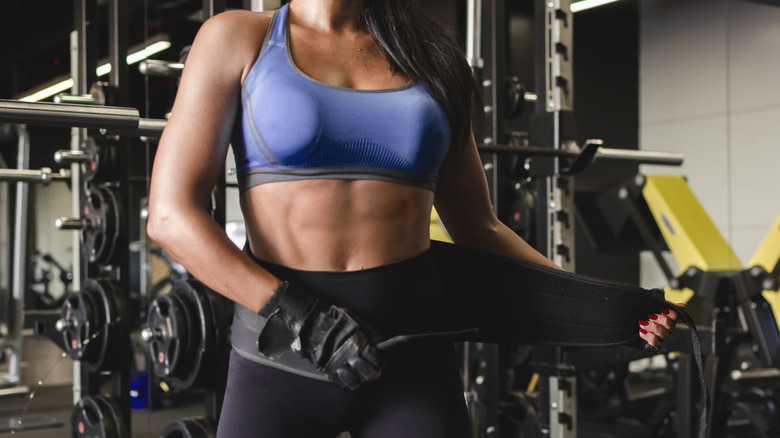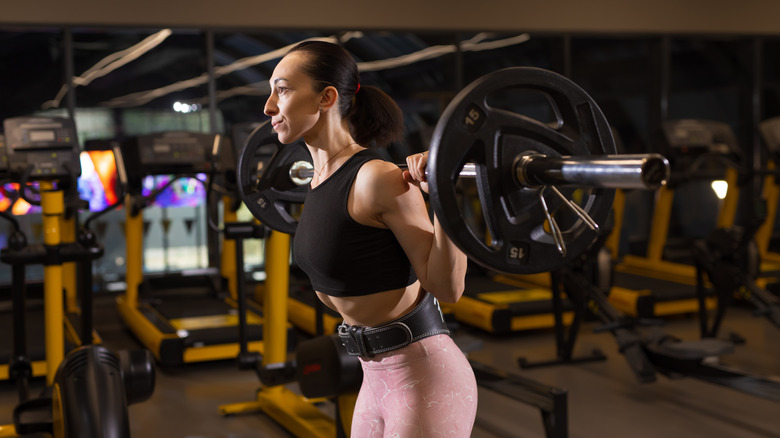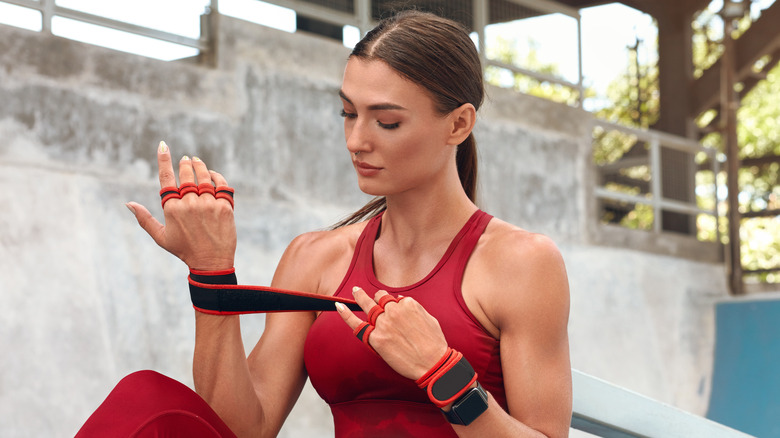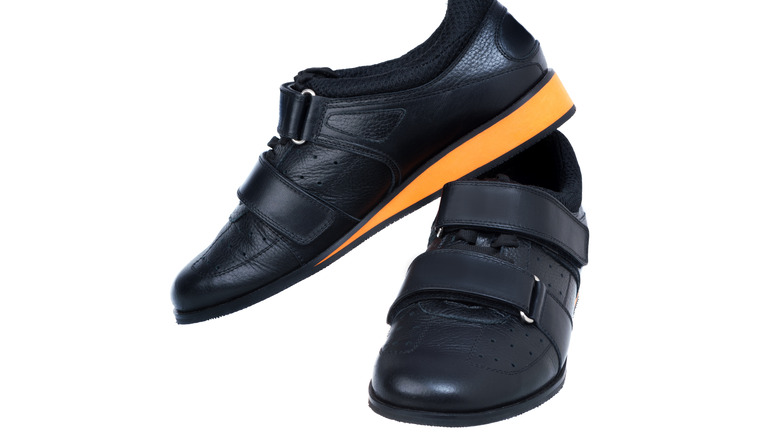Do You Really Need This Gear To Be A Weightlifter?
Gym-goers spend hundreds of dollars on gloves, belts, wraps, sleeves, and other accessories. Some look like they came straight out of a sports magazine. But do you really need all this stuff to be a weightlifter? The answer depends on who you ask.
For example, weightlifting gloves are meant to protect your hands and prevent common issues such as blisters and calluses. These accessories can also be helpful when you have open tears on your palms, says Men's Health. However, it's perfectly fine to lift weights with your bare hands. "In theory, you're 'protecting' your skin from the wear and pounding of metal bars, but you're also losing a ton of natural grip training," said Men's Health Fitness Director Ebenezer Samuel. "When my hand is in direct contact with the weight, I can more easily adjust and be precise with my grip," he added.
What about knee or elbow sleeves, belts, or lifting shoes? Should you go for comfort or save your money for other things?
Should you wear a weightlifting belt?
Squats, deadlifts, shoulder presses, and other strength exercises can put stress on your back. It takes just one wrong move to injure your spine and end up in excruciating pain. Considering these risks, it's no surprise that lifting belts are considered a must-have. The problem is that they are often misused. First of all, these accessories support your core muscles, making it easier to lift heavy loads. Their role is not to protect your back. A large-scale study published in the Journal of the American Medical Association (posted at the National Library of Medicine) found that wearing a belt while handling heavy objects doesn't prevent lower back pain or spine injuries.
The Mayo Clinic explains that lifting belts can help improve your posture and stabilize the spine during exercise. But this doesn't mean they actually protect your spine. What matters most is to use proper lifting form and keep your spine neutral.
Furthermore, competitive powerlifter Tim Henriques told T-Nation that gym-goers who overuse the belt might end up with weak core muscles. He doesn't recommend wearing one when you do leg presses, arm exercises, and other movements that don't directly involve the back and abs.
"Never wear a belt when performing an exercise that has you sitting or lying down," says certified strength and conditioning specialist Dan Trink (via T-Nation). He also points out that you don't need a lifting belt for medium-rep sets performed at 70% (or less) of your one-rep max.
Sleeves and wraps are not always necessary
It's not uncommon to see weightlifters wearing sleeves and wraps around their knees, elbows, or wrists. These accessories have their role, but you probably don't really need them. Knee sleeves, for example, should be worn throughout your entire workout. You'll use these products to stabilize your knees and keep them warm, which may help prevent injuries. Knee wraps, on the other hand, should only be used for heavy squats and leg presses, notes professional powerlifter Avi Silverberg (via Powerlifting Technique). However, they are not meant for the average trainee.
Performance and fitness expert John Rusin told T-Nation that knee wraps are often overused, which may lead to joint problems. Moreover, they can limit your range of motion and keep you from reaching your training goals.
"If you depend on crutches, it's just a matter of time until you fall on your ass and can't get up," says Dr. Rusin. For best results, focus on improving your lifting form, mobility, and technique. Weightlifting gear cannot compensate for poor form or muscle imbalances.
Weightlifting shoes can be a smart investment
If you're a regular gym-goer, you might already have several pairs of sneakers and running shoes in your closet. However, traditional sports footwear is different from weightlifting shoes. The latter have elevated heels and firm soles, making it easier to maintain your balance and generate force from your feet. As a result, they allow for a more upright posture and increased knee flexion when you squat (per the Journal of Sports Sciences, also posted at the National Library of Medicine).
Weightlifting shoes are not necessary for bodyweight squats or core work. But if you're planning to go heavy in the gym, it makes sense to wear special footwear. "Once you are committed to the sport and consistent in training, a good pair of weightlifting shoes will be the most important piece of equipment you need to improve performance," said certified strength and conditioning specialist Lisa Reed in an interview with Shape.
Personal trainer Mat Forzaglia recommends wearing this kind of footwear if you're doing squats, snatches, and other heavy lifts (via Shape). The only exception is the deadlift. A raised heel can make it harder to maintain proper form and get the bar off the ground. If your workout also includes jump squats, sprints, and other types of exercises, your best bet is to opt for crossover shoes. Their design is suitable for dynamic activities, such as running, hiking, and jumping rope, but it also provides the support you need when lifting heavy loads.



